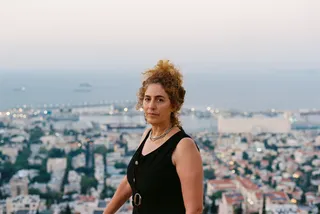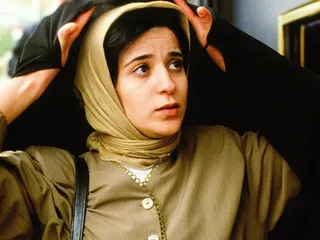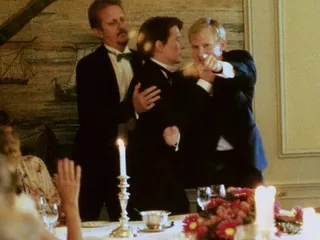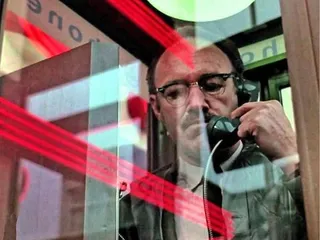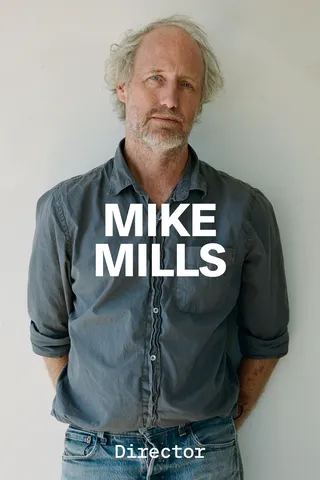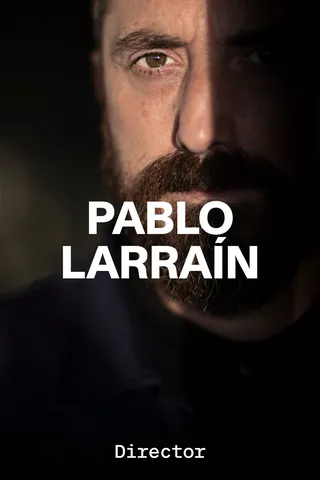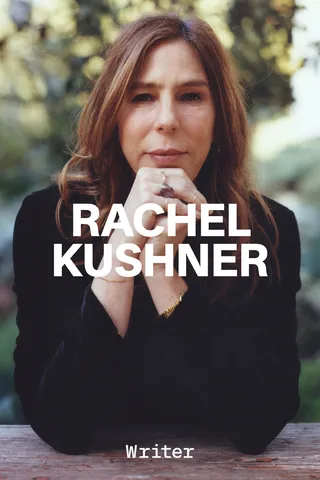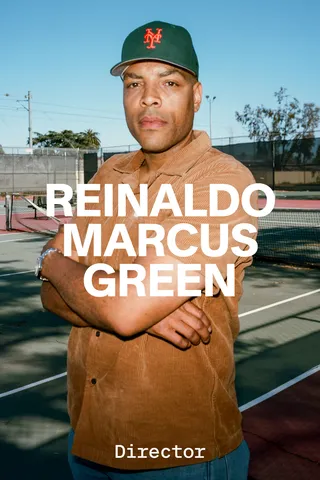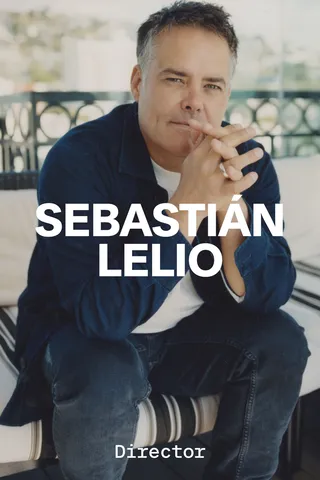Annemarie Jacir
Finding poetry and hope in stories of exile and identity, Annemarie Jacir is a groundbreaking figure in Palestinian cinema and Arab film worldwide. Since directing Salt of This Sea (2008)—the first-ever feature by a Palestinian woman—Jacir has become a regular at major film festivals, earning Palestine’s official nomination to the Academy Awards for that debut as well as When I Saw You (2012) and Wajib (2017). She is also a published poet and acclaimed screenwriter, and co-runs independent production company Philistine Films with her husband, Ossama Bawardi. Jacir’s passion for storytelling blossomed during her childhood in Saudi Arabia, where she had access to books but not movie theaters. “Creativity became our survival mechanism,” she recalls. Her rich cinematic curation for Galerie covers a global spectrum, from Egyptian director Youssef Chahine’s anti-imperialist The Land (1970) to landmark works by Francis Ford Coppola, Jane Campion and Jafar Panahi. John Cassavetes remains a crucial influence on her love of raw performances and flawed characters. “All the imperfections and scars,” she says. “I adore scars.”
“I like flawed characters and intimate storytelling. Being close to them allows for nuance—their struggles, contradictions and emotions.”
my film list
Click each title to discover our curator’s notes and where to watch
I adore this film. I’m a big fan of the 1930s—my new film is set during this period, albeit in a very different world. The 1930s invoke so much about the madness of the world. It was the Great Depression, the birth of jazz, Hollywood’s Golden Age, the end of Prohibition and in my corner of the world, the British-led Mandate of Palestine, the colonial project that would change our history forever. It was a time of great hope, rebellion and change—a moment in our own history where we felt we could beat Goliath. Trouble in Paradise is a feast. I love the direction, the decor and the style. It’s so much fun. And I love the script.
{{ All Items }}I picked this film for what it says about our world and how it says it. The struggle of a working-class mother and the commentary about the film industry and how it invades people’s lives: I was very touched by it. It’s suffocating and gritty. The performance of the mother—who walks a tightrope between trying to be strong, trying to be a good loving mother, while also being too pushy, making the wrong choices and struggling with the terrible mundane reality of humiliation—is incredible to watch. Many men attempt to make feminist stories with female protagonists, but Visconti is one of the few who actually succeeds.
{{ All Items }}I know: It’s on everyone’s list. It’s the French New Wave, a story of youth, an exploration of a city and a specific moment in time. There are so many moving moments in the film, but my favorite is the last sequence: the sense of freedom, life and the open, broken world—and the child’s face. It is truly beautiful filmmaking.
{{ All Items }}A favorite of mine since I first watched it, when I lived in New York. For the first time in my life, I got to live in a city with cinemas that allowed me the chance to see new films, independent films, classic films and obscure films on a big screen. I love the film’s spirit, the slow-burning performances of Warren Beatty and Faye Dunaway, and the use of color. As soon as the opening credits roll, we know that color is important. After that, it’s a journey, a feast for the eyes, to follow the story of the two infamous gangsters. That scene when Bonnie visits her mother—the change of rhythm and the dreamy break from the rest of the film—is incredibly emotional.
{{ All Items }}If I could point out one director who has influenced me the most in the way I’ve learned to work with actors, it is Cassavetes. Faces is painful and raw. I love the way he holds on to moments, to shots, to their fullest emotional capacity. I learned after one of my early films that I had made the terrible mistake of working so much on a script that I suffocated the actors with it. I didn’t allow them to breathe. Since then, I’ve been finding ways to always keep things alive. That is the most important thing. In all the imperfections and scars—I adore scars—my main job is to help an actor find the life of every scene. Cassavetes is a master.
{{ All Items }}As long as I live, I’ll never get the last image out of my head, that bloodied hand grabbing at the earth. It says everything. This film is a masterpiece of anti-imperialist struggle. It hits at the core of everything. Although I grew up with Egyptian cinema playing on TV, I never really watched an Egyptian film or connected with one until Richard Peña introduced me to Youssef Chahine and, in particular, The Land. When I was a graduate student, I remember running into Chahine while he was shooting a film in New York. I introduced myself to him and babbled on about how much I adore his work, how moved I was, et cetera. He just held my hand tightly and adjusted his hearing aid and said, “You are very, very nice!”
{{ All Items }}I am a sucker for thrillers, especially political ones, from classics like North by Northwest to ’90s films like The Fugitive (though perhaps I find it harder to find good thrillers nowadays). I also love obsessive films, when done right. Because I grew up in a slightly paranoid world and live in a place where surveillance continues to mark our lives, The Conversation hits home. This one has aged quite well, as surveillance is even more prevalent than ever before. On top of that, the political atmosphere surrounding us is quite terrifying.
{{ All Items }}I can’t say enough about this film: gorgeous black-and-white cinematography; character-driven story; amazing soundtrack, with one of my favorite musicians (and cast!); and energy that is so Jarmusch, so absolutely hypnotizing. I’ve been listening to Tom Waits since I was in high school and will never have enough. He is experimental, raw, sentimental and rough—pure poetry. Jarmusch’s sense of place is one of the reasons I am so drawn to his work. He creates a world that’s familiar yet at the same time absolutely fantastical—just like Waits does. To be real, so close to the ground and at the same time so free…
{{ All Items }}Nair is a master chameleon. Her energy, her love for life, and her ability to move through hundreds of different worlds, seemingly effortlessly, all show in her films. But it is her earliest feature that is etched in my head. Salaam Bombay! broke my heart into a million pieces. The beauty of the main character’s relationships; the edge between joy and sadness. Nair captures so much in this story: a love for her people and the search for love in an unjust world.
{{ All Items }}I realized while making this list that many of the films are from the same period, more or less. Most likely that’s because I grew up in a country without cinemas and my discoveries came late. When I saw something that affected me, I was deeply affected. Before the Rain plays with time in the most poetic way. It talks about love, war and our broken countries. Manchevski captures in the most cinematic way the feeling of being an outsider, of belonging and not belonging to a place, and of trying to find a way to exist, to be.
{{ All Items }}This, not only for its cinema but for its script. I love the way Vinterberg reveals layers of his characters. I adore this totally cinematic and uncomfortable exploration of family relations. It’s black, it’s raw and it’s emotional. I discovered The Celebration at the New York Film Festival when it first came out and then became a fan of many Dogme 95 films. I feel I age myself when talking about Dogme, in the sense of when I started studying cinema. Clearly I am not a Dogme filmmaker, but the idea of making cinema in actual locations and without tricks is something I am drawn to. I find that the real world can be so magical and strange that, as a filmmaker, I am not personally attracted to, say, science fiction.
{{ All Items }}Jane Campion plus Kate Winslet and Harvey Keitel! I love watching those two actors perform together. I love the energy the film is infused with and the exploration of family relationships, sexual politics and spirituality. Holy Smoke is original, and it is damn funny. I’m a big fan of Campion’s quirky, awkward stories, which are always made with truth and originality.
{{ All Items }}This film is imprinted on my brain forever. I first saw it at the New York Film Festival in early 2000, and I’d never seen anything like it. It’s moving and evocative, full of confidence. I love how Denis chose to retell a classic story in a totally original way and make it absolutely personal. I love the world she creates in the film, her ability to capture rage, jealousy, obsession and the desire to break free. When I close my eyes and think about Beau Travail, entire scenes play out. The images are so strong that I feel like I just saw the film yesterday. This is my favorite Claire Denis work.
{{ All Items }}I watched this when I was a film student. It came during the new wave of Iranian cinema (which I adore), but what I love here is how it turned so much on its head. An urban story, a pizza delivery, a robbery, depression and an examination of class differences in Tehran. I hadn’t seen anything like it, and it felt like a relief from the usual expectations of what cinema from “our region” (and I use the term tongue in cheek) should be. Much of the international audience has certain clichés about “the East,” and they like to see those clichés confirmed in our cinema, whether it’s poverty porn, rural stories or beaten-down women, among many other clichés. Crimson Gold gives us a more nuanced picture of a city, class and modern life—not only a social critique but also a political one.
{{ All Items }}My list is not in order, because if it were, this film would be at the top. All Ken Loach’s films have been influential, but this one remains my favorite. I cannot express how deeply it resonates with me as a Palestinian. Particularly memorable: I invited Ken to Palestine for his first visit and accompanied him across the border from Jordan, along with Paul Laverty and Rebecca O’Brien. We screened the film in Ramallah to an audience of 2,000 people who connected so deeply to the film. We see Ireland, and Ireland sees us.
{{ All Items }}
RELATED MATERIAL
Essays, interviews and other connections
![The Censored Cinema of Iran]() The Censored Cinema of IranRead
The Censored Cinema of IranReadAbbas Kiarostami, Jafar Panahi and the social realists who pierced the veil
By Khashayar J. Khabushani
![Thomas Vinterberg’s Family Albums]() Thomas Vinterberg’s Family Albumsread
Thomas Vinterberg’s Family AlbumsreadThe Danish director on the one choice we don’t get to make
By Wendy Mitchell
![Somebody’s Watching Me]() Somebody’s Watching Meread
Somebody’s Watching MereadRemember when surveillance had a human face?
By Calla Henkel
